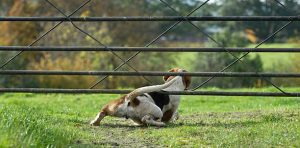Electric dog fences – Weighing up the pros and cons
Electric Dog Fences: Pros and Cons
Electric dog fences are both a safe and affordable solution to keep your dog safe at home whilst allowing them the freedom to roam and play within your properties boundary. In recent years due to their flexibility and effectiveness electric dog fencing has become increasingly popular for cats as well.
It goes without saying that electric dog fencing is not for everyone. It’s important to fully understand how the fences work and weigh up the pros and cons between electric dog fencing and traditional fencing.
How do electric dog fences work?
There are two types of electric dog fences, wired and wireless. The most popular and effective are wired systems.
Wired Fences
The fence consists of a transmitter box, a boundary wire and a small computer collar which is worn by the dog or cat.
The transmitter box is installed on-site and the boundary wire is connected to the transmitter box. The is buried around the perimeter of the property and wire carries the harmless low-level radio signal around the boundary. The pet wears a computer collar that emits a warning beep followed by a mild stimulation (similar to a carpet shock) when he gets too close to the designated area. The no go area for the electric dog fence is marked with some temporary training flags to assist the pet with a visual. The dog fence Installer trains the pet to understand the avoidance area.
Wireless Fences
With the wireless dog fence, there is no boundary wire. The transmitter is located centrally around the area to be fenced. The transmitter sends out a circle of signal from the base station. Unfortunately, wireless dog fences are prone to false activation and are only effective for flat properties with no obstructions for the signal.
When it comes to the electric dog fence there are two types — wireless and in-ground. Even though they work in different ways, both systems consist of some sort of base unit that creates a hidden boundary around whatever area you want to contain your dog in. Read more about wireless dog fences here.
PROS OF ELECTRIC DOG FENCES
- Price – an electric dog fence is far cheaper than a traditional fence and gate.
- Dogs and cats can be allowed to roam freely – not kenneled or caged and exhibit natural behaviour.
- Dog or cat cannot jump over or under and the signal is 360 degrees.
- The driveway is protected so no worries about an open gate or slow electric gates.
- Can be installed on terrains that are not suitable for traditional fencing. Can be used through streams, along towpaths, woodland, steep slopes and areas with planning restrictions.
- Quicker to install than a traditional fence. Up to 10 acres installed in 1 day.
- Electric dog fencing does not restrict views.
- Can be used to keep pets out of areas – pools, play areas, flower beds.
- Easier to maintain than a traditional fence.
- Can be moved from house to house.
- Electric dog Fence collar also works indoors to keep pets out of rooms or off furniture.
CONS:
- Does not keep other dogs, cats or wildlife out of your garden.
- Not recommended for aggressive dogs as with wireless or electric dog fencing there is no physical barrier.
- Batteries in the dog’s collar must be changed every 3, 6 or 24 months (reputable Companies should offer an automatic renewal program).
- If the power goes down the electric dog fence can go down – look for a system with a battery backup.
- Not suitable for dogs in whelp or very old dogs.
- Customer must assist with training so can take dogs up to 10 days to fully learn the fence.
- Must make contractors aware of buried boundary wire if digging or landscaping to avoid damage.
Electric dog fences have been available in one form or another for over 40 years. Recent advances in technology have now brought these fences to another level and items listed in the “cons” list are now easily avoided with the higher specification systems.
The latest electric dog fences
In 2018 DogFence launched their new enabled fence. This new generation of electrical dog fencing gives the owner real-time information and notifications regarding the status of their system. The fence offers a new 2-way communication between the electric dog fence collar and the base station through an app.
Take a peek at our video which explains all the amazing features in the Smart Fence here.
- Sends out an email alert for a wire break
- Sends out an email alert of a challenge to the fence by the pet
- Send out an email alert regarding the battery level.
- Activity tracker for each pet through the app.
These email alerts are also sent out to the DogFence office so we can contact the customer to book a service visit or arrange a replacement battery.
If you would like to know more about our Smart Fence or our other fences please contact us on 01628 476475 or email info@dogfence.co.uk.












